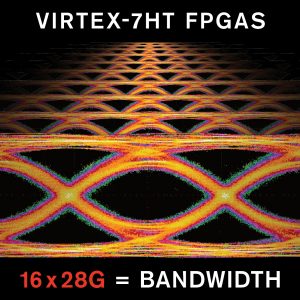Designing with Multi-Gigabit Serial I/O
Course Description
Learn how to employ serial transceivers in your 7 series FPGA design. Understand and utilize the features of the serial transceiver blocks, such as 8B/10B and 64B/66B encoding, channel bonding, clock correction, and comma detection. Additional topics include use of the 7 Series FPGAs Transceiver Wizard,. synthesis and implementation considerations, board design as it relates to the transceivers, and test and debugging. This course combines lectures with practical hands-on labs.
Release Date
June 2015
Level
Connectivity 3
Training Duration
3 days
Audience
FPGA designers and logic designers
Prerequisites
- Verilog or VHDL experience or the Designing with Verilog or Designing with VHDL course
- Familiarity with logic design (state machines and synchronous design)
- Basic knowledge of FPGA architecture and Xilinx implementation tools is helpful
- Familiarity with serial I/O basics and high-speed serial I/O standards is also helpful
Software Tools
- Vivado® System Edition 2015.1
- Mentor Graphics QuestaSim simulator 10.3d
Hardware
- Architecture: 7 series FPGAs*
- Demo board: Kintex®-7 FPGA KC705 board*
* This course focuses on the Kintex-7 architecture. Check with your local Authorized Training Provider for the specifics of the in-class lab board or other customization’s.
Skills Gained
After completing this comprehensive training, you will know how to:
- Describe and utilize the ports and attributes of the serial transceiver in 7 series FPGAs
- Effectively utilize the following features of the gigabit transceivers:
- 8B/10B and other encoding/decoding, comma detection, clock correction, and channel bonding
- Pre-emphasis and linear equalization
- Use the 7 Series FPGAs Transceivers Wizard to instantiate GT primitives in a design
- Access appropriate reference material for board design issues involving the power supply, reference clocking, and trace design
Course Outline
Day 1
- 7 Series FPGAs Overview
- 7 Series FPGAs Transceivers Overview
- 7 Series FPGAs Transceivers Clocking and Resets
- 8B/10B Encoder and Decoder
- Lab 1: 8B/10B Encoding and Bypass
- Commas and Deserializer Alignment
- Lab 2: Commas and Data Alignment
Day 2
- RX Elastic Buffer and Clock Correction
- Lab 3: Clock Correction
- Channel Bonding
- Lab 4: Channel Bonding
- Transceiver Wizard Overview
- Lab 5: Transceiver Core Generation
- Lab 6: Simulation
- Transceiver Implementation
- Lab 7: Implementation
- Physical Media Attachments
Day 3
- 64B/66B Encoding and the Gearbox
- Lab 7: 64B/66B Encoding
- Transceiver Board Design Considerations
- Transceiver Test and Debugging
- Lab 9: Transceiver Debugging
- Lab 10: IBERT Lab or
- Lab 11: System Lab
- Transceiver Application Examples
Lab Descriptions
- Lab 1: 8B/10B Encoding and Bypass – Utilize the 8B/10B encoder and decoder and observe running disparity. Learn how to bypass the 8B/10B encoder and decoder.
- Lab 2: Commas and Data Alignment – Use programmable comma detection to align a serial data stream.
- Lab 3: Clock Correction –.Utilize the attributes and ports associated with clock correction to compensate for frequency differences on the TX and RX clocks.
- Lab 4: Channel Bonding – Modify a design to use two transceivers bonded together to form one virtual channel.
- Lab 5: Transceiver Core Generation – Use the 7 Series FPGAs Transceivers Wizard to create instantiation templates.
- Lab 6: Simulation – Simulate the transceiver IP using the IP example design.
- Lab 7: Implementation – Implement the transceiver IP using the IP example design.
- Lab 8: 64B/66B Encoding – Generate a 64B/66B core by using the 7 Series FPGAs Transceivers Wizard,.simulate the design, and analyze the results.
- Lab 9: Transceiver Debugging – Debug the transceiver IP using the IP example design and Vivado debug cores.
- Lab 10: IBERT Lab – Create an IBERT design to verify physical links.
- Lab 11: System Lab – Perform all design steps from planning the design, generating the core,.integrating the core into a design, simulating, implementing and debugging the design,.and optimizing the link parameter using an evaluation board.

Datum
02 juli 2019 - 04 juli 2019
Locatie
Core|Vision
Cereslaan 24
5384 VT
Heesch
Prijs
€ 0,00
of
27 Xilinx Training Credits
Informatie
Training brochure
Registratieformulier
Registratie op aanvraag, neem contact op met ons.
